Minneapolis Police Department
| Minneapolis Police Department | |
|---|---|
| Abbreviation | MPD |
|
Patch of the Minneapolis Police Department | |
|
Badge of the Minneapolis Police Department | |
| Motto | To Protect with Courage, To Serve with Compassion |
| Agency overview | |
| Formed | 1867 |
| Preceding agency | Municipal Police |
| Employees | 1100 |
| Legal personality | Governmental: Government agency |
| Jurisdictional structure | |
| Operations jurisdiction* | City of Minneapolis in the state of Minnesota, USA |
 | |
| Map of Minneapolis Police Department's jurisdiction. | |
| Size | 58.4 square miles (151 km2) |
| Population | 382,578 (2010) |
| Governing body | Minneapolis City Council |
| General nature | |
| Operational structure | |
| Overviewed by Civilian Board | Minneapolis Civilian Police Review Authority Board |
| Headquarters | Downtown Minneapolis City Hall |
| Police Officers | 800 |
| Civilians | 300 |
| Agency executives |
|
| Units |
List
|
| Precincts |
List
|
| Website | |
| Minneapolis Police | |
| Footnotes | |
| * Divisional agency: Division of the country, over which the agency has usual operational jurisdiction. | |
The Minneapolis Police Department (MPD) serves the city of Minneapolis in the U.S. state of Minnesota. Formed in 1867, it is the second oldest police department in the state of Minnesota, after the Saint Paul Police Department (formed in 1854). A short-lived Board of Police Commissioners existed from 1887 to 1890.
The modern department is organized into three bureaus all reporting to Chief of Police Janeé Harteau.
The city is served through five precincts[2] with 800 sworn officers and 300 civilian employees.[3] At the city's population peak, MPD served over 521,000 people, and today serves over 411,000 people as of the last Census estimate.
Other independent protection organizations serve the city, identified as partner law enforcement agencies, these are the University of Minnesota Police Department (UMPD), Minneapolis Park Police, Metro Transit Police, and the Hennepin County Sheriff's Office. The Metropolitan Airports Commission Police serves the Minneapolis-Saint Paul International Airport in unincorporated Hennepin County.
History
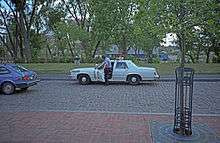
In the 19th century, the City of St. Anthony and Town of Minneapolis were first adequately served by an appointed city marshal based out of St. Anthony who was assisted by constables. Vested with the power of arrest, they rarely used it.[4] Criminals sentenced would be sent to Ramsey County Jail or the Stillwater Penitentiary until the Hennepin County Courthouse and Jail was built in 1857. When the two cities merged and incorporated as Minneapolis in 1867, Mayor Dorilus Morrison immediately appointed H. H. Brackett as the first police chief. With six patrolmen, the new Police Department of Minneapolis served a population of about 5,000 people.[3] In 1884, the force numbered 100 men and Shingle Creek workhouse was completed.
In 1887, by act of the new Minnesota Legislature and accorded by the Minneapolis City Council, the Board of Police Commissioners was appointed. Vesting all control of the force to the Board, it was an attempt to thwart the corrupt Mayor "Doc" Ames who had replaced the police force with crooks.[5] The Board was short-lived for three terms until it was abolished in 1890 and a new mayor was elected. Military titles were also abolished. By then the city grew to 200,000 people with 200 officers on a budget of $209,278.[4] Patrols were done on foot and by horseback with headquarters at city hall. By 1909, the department added motorcycles, fingerprinting, and utilized telephones.
Racial Disparities
In 2001, the tactic of racial profiling came to issue as the State Legislature attempted to mandate data collection of a person's race in traffic stops to reveal profiling trends. Though the measure was defeated, departments were offered incentives to volunteer for a pilot project to collect the data.[6] MPD released its report in 2003 indicating it was more likely to stop a non-white person. The city under Mayor R.T. Rybak convened an audit of MPD to determine why and formulate steps to address the issue.[7]
Despite these and other programs and promises of police reform, actual improvements have been only marginally effective and, according to some, have regressed going into 2016.[8][9][10]
Low level arrests
Black people account for 60% of Minneapolis Police Department's low-level arrests, overall. Between 2012-14 Minneapolis police arrested Blacks nearly ten (10) times more for low-level offenses than whites. Police officers have more options for how to respond to low-level offenses, which, if they lead to an arrest can start or sustain a downward spiral of a life-cycle of arrests, incarceration and unemployment. Of nearly 10,000 low-level arrests over 33 months made by 1,017 Minneapolis officers between 2013–14, the vast majority were made by eight officers. Seven averaged between 1,000-1,250. One made 2,026. In 2014, The average low-level arrests per officer was 51. Even taking out the eight officers who make the majority of arrests, black citizens were still arrested 8.5 times more than whites were for overall low-level violations. Low-level offenses include things like: curfew violations, loitering, trespassing, drinking in public, and open bottle.[11]
In a letter [12] to Minneapolis Mayor Betsy Hodges and chief Harteau, the American Civil Liberties Union of Minnesota and its Criminal Law Reform Project reported that the State of Minnesota was the third highest in the country for arrests for possession of marijuana, at nearly 8%, compared to the national average of under 4%; and that Minneapolis Police Department's rates "are even worse." Between 2004 and 2012 the Department was, on average, 11.51 times more likely to arrest an African American person than a white person for marijuana possession. The inequities extended past controlled substances arrests. For the same period Minneapolis blacks were 8.86 more likely than whites to be arrested for disorderly conduct, 7.54 times more likely than whites to be arrested for vagrancy; and Minneapolis youth were 16.39 times more likely than white youth to be arrested for curfew or loitering offenses.[13]
Incarceration rates
As the largest city in Hennepin County, Minneapolis contributes significantly to it's disproportionate incarceration of black citizens. In 2012-14 the incarceration rate for blacks was nearly 10 times that of the whites. In 2015, 50% of all youth imprisoned in the State of Minnesota were black youth from Hennepin County.[14] That same year, 35% of adult inmates in Minnesota, 25% of whom were from Hennepin County, were black.[15]
Police shootings
Of the 149 Minnesotans killed by police between 2000 and 2015, over a one-third (67) were people of color.[16][17]
The Minneapolis police shooting of Jamar Clark on November 16, 2015 heightened tensions between the city and its citizens. Clark, a 24-year-old African-American man who family say was starting to find his way after a troubled past, died two days later. Police said that Clark reached for officer Dustin Schwarze's gun when Schwarze and officer Mark Ringgenberg responded to a domestic violence call, but several witnesses disagreed, saying that Clark was handcuffed and thus unable to at the time. Mayor Betsy Hodges requested an investigation by the United States Department of Justice Civil Rights Division of the federal government.[18] The U. S. Department of Justice (DOJ) arrived a week later. Eight months later, Hodges announced that the DOJ had declined to bring civil rights charges.[19]
Both Schwarze and Riggenberg had been previously sued for misconduct in federal court.[20][21]
Nonviolent demonstrations
In response to the Clark shooting, citizens organized an extended sit-in at the Department's Fourth Precinct, which is responsible for public safety in north Minneapolis, where Clark had been killed. Numerous other demonstrations were held in and around Minneapolis, calling for charges against the officers and the release of videotapes of the incident. Online efforts, including from a petition by Color of Change with 70,000 signatures,[22] supported the in-community protests.
City leaders and the Minnesota Bureau of Criminal Apprehension (BCA) refused to release the videotapes, citing the ongoing investigation. Minnesota Governor Mark Dayton was allowed to view them and reported that they were "inconclusive." In February 2016, the NAACP and ACLU sued the DOJ to release the videotapes.[23][24][25]
Police and protesters initially exchanged charges of violence by the other at the precinct occupation, but, police Chief Harteau denied claims that protesters had fired shots and thrown molotov cocktails, instead blaming the incitements on "anarchists" from outside the area.[26]
Black Lives Matter demanded that Hennepin County bypass the traditional Grand Jury process for determining whether to press charges against the officers, arguing that Grand Juries rarely prosecute police. In November 2015, Freeman initially balked.[27] But, in a victory for protestors who had conducted weekly demonstrations at his office for what they called Freeman Fridays, the prosecutor changed his mind with a statement released on March 16, 2016, citing the fact that Grand Jury proceedings lack the level of transparency the citizens were demanding. In addition, Freeman also announced that that he'd stop all use of Grand Juries in any future police-involved shootings.[28] On March 30, 2016 Freeman announced that he would not charge the officers, citing evidence that they'd acted within legal boundaries.[29] (See also, Shooting of Jamar Clark)
Minnesota Lynx
Minneapolis police officers rejected a t-shirt that Minnesota Lynx captains wore at a pregame press conference meant to draw attention to problems between police and blacks, with four of them announcing they'd disrupt their off-hours contracts to provide security for the Lynx WNBA basketball games.[30] The front of the shirts featured the phrase "Change Starts With Us: Justice & Accountability." On the back was the Dallas Police Department emblem and two black men, to honor Dallas officers who had been killed in a mass shooting during a protest there, and the names of Philandro Castile and Alton Sterling who had been killed by police in Falcon Heights, Minnesota and Baton Rouge, Louisiana, respectfully; the bottom read "Black Lives Matter." Other current and retired professional teams and athletes supported the players.
The Lynx players made clear that they sought healing and progress not blame.
"You'll see on the backs of our shirts that we're highlighting a longtime problem of racial profiling and unjust violence against blacks in our country. But we do not in any way condone violence against the men and women who service in our police force. Senseless violence and retaliation will not bring us peace." (Lynx Captain Maya Moore, in a pregame press conference)
Chief Harteau expressed disappointment in the officers. "Although these officers were working on behalf of the Lynx, when wearing a Minneapolis Police uniform. I expect all officers to adhere to our core values and to honor their oath of office," she said in a statement addressing their announcement. "Walking off the job and defaulting their contractual obligation to provide a service to the Lynx does not conform to the expectations held by the public for the uniform these officers wear." Mayor Hodges comments were even stronger in her response to ugly comments by the head of the police union.[31]
In contrast to the police chief, the president of the Police Officers Federation of Minneapolis called the team "pathetic" while saying he "commended" the officers, before threatening that other officers might follow suit, saying: "If (the players) are going to keep their stance, all officers may refuse to work there." [32]
"Bob Kroll's remarks about the Lynx are jackass remarks," wrote the mayor on a Facebook post. "Bob Kroll sure as hell doesn't speak for me about the Lynx or about anything else." [33]
Raids on Chinese
During the Great Depression, Minneapolis police raided and investigated its own Chinese population of the Chinese Exclusion Act era. In 1925, Chief Frank Brunskill instructed captains to "investigate every Chinese on his beat" for naturalization papers or other identification.
Misconduct and Internal affairs
Complaints
Responding to increasing concerns, in 2016 a study commissioned by the City's Police Conduct Oversight Commission found that making a misconduct complaint at most Minneapolis Police precincts or online resources was difficult if not nearly impossible. When undercover lawyers tested Department personnel and system they observed numerous cases of obstruction or unnecessarily complicated processes.[34][35][36] Notably, the Department's 4th Precinct, which is located in north Minneapolis, a hotspot for crime and tensions between police and the community, was found to be the best at receiving complaints at the time. Perhaps related to heavy scrutiny it received after the police Shooting of Jamar Clark, a young black man there, in 2015.
When citizens have succeeded in filing complaints about Minneapolis police misconduct, however, little meaningful action has been untaken by the Department. During one period more than half of the 439 reviewed complaint cases were dismissed because they were older than 270 days. No officers were disciplined.[37]
Misconduct lawsuits
Minneapolis made $14 million in payouts for alleged police misconduct between 2006 and 2012 [38]
Hamza Jeylani threat
In 2015, Minneapolis officer Rod Webber threatened a black teenager, Hamza Jeylani, who captured the incident on his phone. "Plain and simple, I'm going to be honest with you. If you fuck with me I'm going to break your legs," Webber told Jeylani. When Jeylani asked Webber why he was being pulled over, Webber replied, "because I feel like arresting you." [39]
Green Bay incident
The Department did respond, however, when the Green Bay, Wisconsin Police Department responded to a disturbance that two off-duty Minneapolis police officers were involved in. Both officers were subsequently fired. The incident began with Brian Powell and Shawn Thune, both employed at the department's north Minneapolis precinct at the time, texting a Green Bay officer he knew, Nate Allen, referring to Allen as "Nigs," and, when Allen didn't respond, "you faggots." Referring to a black man who drove by, he said to Allen and another Green Bay officer, "What is that? Green Bay is too nigger friendly." Powell repeated the racial slur a number of times later related to a clash he and Thule had with four black men, at least one of whom Powell hit in the face. Questioned about what started the incident, Powell told Green Bay police that the other men were "doing their monkey shit." [40] When Green Bay officers didn't pursue the black citizens, the Minneapolis officers became abusive with their professional peers, calling them "fucking jokes," and repeatedly disparaging them with similar language. Thule tried to talk them out of making a report because, he said, "I have a lesbian fucking chief who's looking to fire people for any reason."[41]
Both officers had previous misconduct issues. Powell was involved in a lawsuit against the City related to he and other officers severely beating an African American man in 2010. The suit was settled with Minneapolis paying the victim $235,000.[42] Powell was also involved in a lawsuit for the wrongful death of a Somalian man who, according to legal documents, was brutally assaulted, tortured and killed.[43]
Mike Spann beating
Three white Minneapolis police officers were charged in the beating of an African American man in a suburb south of Minneapolis, in 2013. William C. Woodis, Christopher J. Bennett and Andrew R. Allen were off-duty and having drinks at a bar when a black man introduced himself to them. When Apple Valley, Minnesota police were called the officers claimed that Spann followed them out of the bar, but security camera footage showed them following him. Spann's nephew, who was also hit by the officers, as well as another witness who did not know Spann or the officers, said that the officers were "on attack." Woodis and Bennett pled guilty to misdemeanor charges of disorderly conduct. Charges against Allen were dropped.[44]
Civil Rights stalls
In 2002, Olson was accused of stalling federal U.S. Department of Justice mediation between the MPD and hometown civil rights groups focused around North Minneapolis.[45] Unpopular with Mayor R. T. Rybak, Olson was ousted in 2003 and William McManus was appointed, former chief of Dayton, Ohio, and former assistant chief in Washington, D.C.[46] His tenure was intended to reverse Olson's past actions. McManus worked on improving internal promotions and politics within the department to achieve racial equality in officer ranks. The attempted overhaul of Internal Affairs and greater attention over policing did generate larger respect for the department from communities of color and even gang members.[47] However, his support was split in the Council, and though personally endorsed, he conflicted with Mayor Rybak over promotions and the handling of the 2003 Duy Ngo incident, in which Ngo, an undercover officer, was shot by another officer.[48] In early 2006, facing an uncertain reconfirmation for a second three-year term, McManus sought and accepted the police chief position in San Antonio, Texas.[49][50]
Though McManus improved internal diversity during his tenure, his efforts did not address department racism, traced to former chief Olson, and continuing under chief Harteau.[51][52][53] In December 2007, five high ranking black police officers filed a lawsuit against the department alleging a long history of systemic racial discrimination and a hostile working environment toward black officers[54] and in April 2009, the city settled with them for $740,000.[55]
Community relations
The department sought to strengthen community relations with its Community Crime Prevention/Safety for Everyone (CCP/SAFE) program. Specialists were trained to assist neighborhoods in organizing block clubs and disseminate crime information to residents.[56] The Neighborhood Revitalization Program (NRP) which began in 1960 has just begun to realize its infrastructure and community improvements, as neighborhoods once severely impacted by crime and deterioration had begun to turn around. The Whittier neighborhood became a model example of the program's benefit.[57] CODEFOR finally reached a decade of data collection revealing definitive crime trends and in 2007, the precincts implemented official neighborhood policing plans based on this data.[58]
Strikes
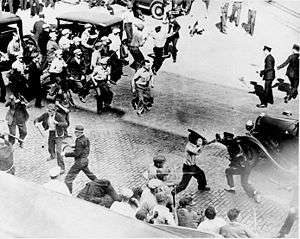
The Minneapolis Teamsters Strike of 1934 was set in May 1934 in the city market (North Loop, Minneapolis) when a new truckers union was not recognized. MPD attempted to open the markets, which were the source of most goods and produce in the city but were blocked by teamsters. Assisted by the Minnesota National Guard and a local militia, the two sides clashed violently for a month with police using gas bombs and brandishing rifles.[60] It ended on August 21 when the union was recognized. Though 200 were injured and four were killed, the strike was a significant event in state and national labor history.[61]
With American prosperity, Minneapolis reached its peak population of over 521,000 in the 1950 Census and MPD had nearly 600 sworn officers. The demographics of Minneapolis also identified in the 1950 census as 98% white.[3] While national politics and anti-communism sentiment played out during this decade, urban renewal ravaged the downtown areas and cleared slums, impacting poor communities.[62] Police contended with protests to this clearance and freeway and expressway revolts later in the 1960s.
Protests and riots
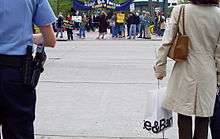
The 1960s posed new challenges to the department from increased drug use, counterculture, and societal unrest. Rioting in Minneapolis followed similarly to inequality riots across many major U.S. cities during that era in predominantly African-American communities.[63] Most notably, the Plymouth Avenue Riots in the Near North neighborhood, instigated by East Coast protesters, effectively emptied the area of Jewish and German businesses.[64] The Police Department's poor engagement with the riots resulted in the Community Relations Division and the Model Cities Precinct in 1970.[65] The Minneapolis Domestic Violence Experiment was conducted in 1981 and the study's prolific release led to changes in police protocol with domestic calls in other departments, notably, New York City, Dallas, and New Zealand.[66] From this tumultuous era, the construction of the freeway system and subsequent white flight emptied Minneapolis' population to a low of 368,383 in 1990. However the demand for policing continued to rise to over 700 officers in that decade as drug use and gang activity continued to accelerate.[48]
In 1998, the re-routing of Minnesota State Highway 55 brought protests from the Hiawatha neighborhood of Longfellow community and members of the Mendota Mdewakanton community. Police protection was ordered for construction workers.[67] In July 2000, a clash with protesters at an International Society of Animal Genetics conference and a following raid on a non-profit office suspected of organizing the protest drew attention of the City Council.[68] They publicly questioned Chief Olson who revealed that 40 undercover police agents were in the demonstrations and that 400 to 500 Minneapolis police officers were assigned to the week-long conference.[69]
Crime and crime rates
In 1995, Mark Koscielski, a gun shop owner in present-day Midtown Phillips coined the term "murderapolis." His T-shirts featuring the derisive term were quoted in a New York Times article.[70] Murders had indeed peaked that year and the department sent three officers to New York City to study the Fixing Broken Windows crime-prevention program implemented by then Mayor Rudy Giuliani and Police Chief William Bratton.[71] The officers returned to implement a new policing strategy, the Computer Optimized DEployment - Focus On Results (CODEFOR). A computer-based system, the strategy involves every unit of the MPD from patrol to special units to identify and concentrate policing on hot spots of crime. As technology has improved, the department continued to collect and increase reliance on statistical and data-based information.[72]
Similar to other cities nationally, crime plummeted in Minneapolis by 42% from 2005 to 2011.[73][74]
Organized crime

In the 1920s, criminal activity had grown to an alarming level. Saint Paul's Chief of Police, John J. O'Connor, established the O'Connor System which allowed gang-land criminals to live in the city as long as they committed no crimes there. In exchange, police provided protection and tips regarding impending federal raids and helped keep criminals free by refusing to extradite them elsewhere.[76][77] As a result, high-profile criminals such as Machine Gun Kelly, John Dillinger and Baby Face Nelson took refuge in St. Paul and committed crimes across the region, including Minneapolis. These criminals then fled to St. Paul, where they were all but untouchable. Soon, the corruption spread to the Minneapolis Police Department, who instituted their own similar system.[78] An Irishman named Edward G. "Big Ed" Morgan operated a gambling den under police protection but also commanded crime in partnership with Prohibition bootleggers. Then, Danny Hogan, an underworld "Godfather" of Saint Paul allied with Morgan.[77]
The police of Minneapolis and St. Paul are said not to interfere with these criminals, there being an understanding between Dan Hogan and the St. Paul Police and Edward Morgan and the Minneapolis Police that if the criminal gangs controlled by them refrain from committing crime in the Twin Cities, that they will not be disturbed. It is a well known fact in the community that a very little crime such as bank robberies, etc, is committed here, the criminals are safe as long as they live up to the pledge made by Dan Hogan and Edward Morgan to the local police.|1926 FBI Memo|[77]
The Department profiled the community's Chinese population in response to Minneapolis events of the Tong wars killings between the local Hip Sing Tong and On Leong Tong.[79] The raids and arrests were ineffective and no Chinese were deported. The tensions faded with the gradual assimilation of the city's small Chinese population and repeal of exclusion laws.[79]
The Great Depression and the 1930s followed similarly to other growing U.S. cities as the department quelled labor disputes and continued to fight gangsters during the waning years of Prohibition. On December 16, 1932, members of the infamous Barker-Karpis gang robbed the Third Northwestern Bank in downtown Northeast, Minneapolis and killed responding policemen Ira Leon Evans and Leo Gorski. The sensational manner in which the gang blasted their way out led to an intense manhunt that netted some of the culprits but not the leaders who had fled.[80][81] In a sign of the Great Depression, the city controller's office revealed that the two patrolmen had been working without pay due to a shortage in the police fund.[82] Mayor Anderson blamed "large taxpayers" as not paying their fair share of taxes, shortening the police budget and limiting the department's ability to fund and equip officers.[80]
Gangs
Tensions among gangs following the acquittal of officers in the Rodney King beating trial in Los Angeles led to one of Minneapolis' darkest moments.[83] On September 25, 1992, Officer Jerome (Jerry) Haaf was taking a break at the officers' popular Pizza Shack restaurant in Phillips and was shot behind the back by two Vice Lord gang members. The investigator with him was also wounded. Haaf died from his wounds at Hennepin County Medical Center and the members were later caught, convicted and sent to prison.[84] Chief John Laux suggested the murder was possibly retaliation for an earlier incident in which Metro Transit Police removed a blind black man who did not have bus fare. At a community meeting earlier in the evening at North Community High School, gang members interrupted calling police brutality and insensitivity.[83] The group's message had exacerbated a real ongoing issue of police brutality in the latter century. Former police chief Tony Bouza who oversaw the department in the 1980s called the force at the time "brutal." Mayor Sharon Sayles Belton, an African-American herself, stated in 1994 that excessive force was a problem.[85]
Disaster response and military support
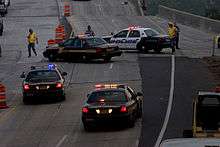
Assistant Chief Tim Dolan succeeded McManus and was shortly promoted to Police Chief.[86] Sharon Lubinski was appointed Assistant Chief.[51] Under Chief Dolan's watch, the I-35W Mississippi River bridge collapsed on August 1, 2007. Agencies involved in the recovery efforts operated smoothly under post 9/11 disaster and emergency management training. Providing 75 law enforcement units,[87] the MPD's immediate role was to ensure safety and control of neighborhoods surrounding the bridge. For several months after, the traffic control unit was on call to direct traffic.[88] The Minneapolis Emergency Communications Center (911 center) was recognized in 2008 for their efficient role in the incident.[89]
During World War II, 117 MPD officers were sent to Europe. At home, the stress of the war and fear of attack developed into air raid drills where two wardens were assigned to each city block.[90] Following the war, the program was chartered by the city as the Police Reserve under MPD's Civil Defense unit in 1952.[91] The Reserve bolsters MPD presence at major events to this day.
Organization
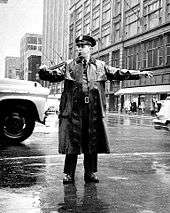
The head of the Minneapolis Police Department is the Chief of Police and the Assistant Chief.[3] The department is organized into three administrative bureaus: Patrol, Investigations, and Professional Standards each led by a Deputy Chief. The Patrol Bureau divides the city into five precincts each with a Precinct Commander, given the rank of Inspector. MPD operates under a decentralized structure giving independence to each precinct and bureau to manage crime and policing.
Patrol Bureau
The Patrol Bureau provides comprehensive police services such as 911 response, crime prevention, traffic control and emergency services. The bureau comprises the five precincts, the Special Operations Division, Community Crime Prevention/SAFE Central and the Police Athletic League.
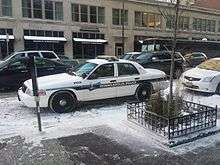
Special Operations Division
- Bomb-Arson Unit
- Canine
The Minneapolis Police Canine Unit has 17 canine teams and the training facility is in Northeast, Minneapolis.[92]
- Homeland Security
- Mounted Patrol
The Minneapolis Mounted Patrol Unit is headquartered at the First Precinct and has 8 full-time riders of the 30 fully trained MPD sworn officers in the unit. It is the largest mounted patrol in the five-state Upper Midwest and operates on donations. Minneapolis owns 11 horses that commute from a rented barn in Delano, Minnesota. Part of the older waterworks plant in Columbia Heights will be converted into a new stable.[93][94]
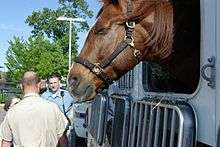
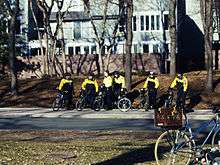
- Police Activities League (PAL)
- Special Events/Reserve
- Strategic Operations Unit
- Special Weapons and Tactics (SWAT)
- Traffic Enforcement and Accident Investigation
- Traffic Control
Investigations Bureau
The Investigations Bureau performs comprehensive investigative services, including case management, suspect criteria, victim support and preparation of evidence for court. The bureau comprises the Criminal Investigations Division, Crime Lab and Support Services.
Professional Standards Bureau
The Professional Standards Bureau focuses on the integrity of department employees from background screening through hiring and ongoing training and maintains the technical operations of the department. The bureau comprises the Background Unit, Internal Affairs, Mediation Compliance, Recruitment, Training, Business Technology Unit and Intellectual Properties.
- Business Technology
- Internal Affairs
- Training
Volunteer units and activities
The Minneapolis Police Reserve is a volunteer 60 non-sworn officer unit in charge of emergency preparedness, general public safety, and provides major support for traffic and crowd control. Officers are non-sworn and wear a light blue uniform with black slacks. Conceived after World War II as the civil defense force in anticipation of a nuclear attack during the Cold War, the reserve's role diminished after the Soviet-era. The unit's responsibility however was reaffirmed after the attacks of September 11, 2001 and was reassigned under the Minneapolis Police Department's Emergency Preparedness Coordinator, tasked with domestic defense in situations of civil unrest and disasters.[91] Though officers are not on regular active patrols, they are on-call 24 hours and respond to rioting, protests, officer shootings, large crime scenes, fires and explosions, and natural disasters, as well as events requiring a security presence such as dignitaries and concerts. They also provide officers to traffic control.[91]
The MPD also has other volunteer activities including
- Police Band
- Police Chaplain Corps
- Police Explorers
- Police Athletic League (PAL)
- Block Club Leaders
- Police Precinct Advisory Councils
- McGruff House Program
- Community Justice Project
Rank structure
| Title | Insignia | Insignia (dress uniform cuff) |
|---|---|---|
| Chief of Police | Four gold stripes and one gold star | |
| Assistant Chief | Three gold stripes and one gold star | |
| Deputy Chief | Three gold stripes | |
| Inspector | Two gold stripes | |
| Commander |  |
Two gold stripes |
| Lieutenant | Gold stripe | |
| Sergeant | ||
| Police Officer / Investigator |
In Television
In the fall of 1990, the Department was featured on the first six episodes of Season 3 of the police reality show, COPS. The department was later featured in Season 21 of the show, which aired in 2008 and 2009.[96]
Other agencies
Five other police forces operate in Minneapolis with the Minneapolis Police Department being the largest.
- The University of Minnesota Police Department (UMPD) serves the University of Minnesota's Twin Cities campus. The department employs over 50 sworn officers. The Chief of Police is Matt Clark, the former Assistant Chief of the Minneapolis Police Department. Under Clark's watch, the UMPD increased its cooperation with the Minneapolis Police Department and now frequently responds Minneapolis' calls for service and backs up MPD Officers in need of assistance.[97]
- The Minneapolis Park Police Department had 22 sworn patrol officers and 21 park patrol agents as of 2008 who are responsible for law enforcement in city parks.[98]
- The Metro Transit Police Department (officially Metropolitan Transit Police) patrols bus routes and light rail and as of 2008 had 60 full-time and 60 part-time officers.[99]
- The Metropolitan Airports Commission has a police force.[100]
- The Hennepin County Sheriff's Office with 800 licensed and civilian members is headquartered in Minneapolis.[101]
See also
Notes
- ↑ Roper, Eric (November 30, 2012). "Council approves Harteau as new police chief". Star Tribune. Retrieved November 30, 2012.
- ↑ "Police Precincts & Neighborhoods". ci.minneapolis.mn.us.
- 1 2 3 4 "Inside the Minneapolis Police Department". City of Minneapolis. Retrieved 2007-12-25.
- 1 2 Isaac Atwater (Published 1893). History of the City of Minneapolis, Minnesota. Munsell. Check date values in:
|date=(help) - ↑ Dara Moskowitz Grumdahl (October 11, 1995). "Minneapolis Confidential Continued from page 3". City Pages.
- ↑ Brandt Williams (February 13, 2001). "Ventura to Oppose Collection of Racial Profiling Data". Minnesota Public Radio. and Dan Gunderson (February 5, 2002). "Some Minnesota police collecting racial profiling data". Minnesota Public Radio.
- ↑ Brandt Williams (November 25, 2003). "Minneapolis to take closer look at racial profiling". Minnesota Public Radio.
- ↑ "For Decades Minneapolis Police Have Been Accused of Racial Bias," Minneapolis Star Tribune
- ↑ "Understanding Disparities between Black and White Residents in the Twin Cities: Metro Stats," The Metropolitan Council, September 2015
- ↑ [Magan, Christopher. http://www.twincities.com/2016/04/29/minnesotas-racial-disparities-worsening-why-and-why-it-matters/ "Minnesota's Racial Disparities Worsening," St. Paul Pioneer Press, 29 April 2016]
- ↑ "Picking up Pieces," American Civil Liberties Union
- ↑ 9Samuelson. https://www.aclu-mn.org/files/3814/1442/7424/Letter_to_Hodges_and_Harteau_10.28.14.pdf "American Civil Liberties Union Criminal Law Reform Project," ACLU, October 28, 2014]
- ↑ "Action Request: Basilica of St. Mary in Minneapolis, Catholic and Christian Churches," A letter to the Pope Francis, The Vatican and American Churches from Me to We Racial Healing, August 31, 2016
- ↑ "Juveniles Resident Inmate Profile," Minnesota Department of Corrections, July 1, 2015
- ↑ "Adult Inmate Profile," Minnesota Department of Corrections, July 1, 2015]
- ↑ [Bjorhus, J.; Webster, M.; Hargarten, J.; Smith, K. http://www.startribune.com/database-of-deaths-after-police-use-of-force-in-minnesota-since-2000/350729601/ "Fatal Police Encounters," Minneapolis Star Tribune, June 2016]
- ↑ [Kindy, Kimberly; et al. "A Year of Reckoning: Police Fatally Shoot Nearly 1000," The Washington Post, Dec 16, 2015]
- ↑ [Nelson, Tim; Williams, Brandt http://www.mprnews.org/story/2015/11/16/protests-erupt-after-mpls-shooting "Hodges asks feds for civil rights probe in Mpls police shooting," Minnesota Public Radio, November 16, 2015]
- ↑ [Hodges, Betsy https://mayorhodges.com/2016/06/01/federal-decision-in-clark-case/"Federal Decision in Clark Case," Blog: Mayor Betsy Hodges, June 1, 2016]
- ↑ Rietmulder, Michael "Dustin Schwarze, Cop in Jamar Shooting Sued for Tasering Suspect (Video)," City Pages, December 1, 2015
- ↑ Mullin, Mark "Mark Ringennberg, Cop in Jamar Clark Shooting Allegedly Chocked Guy While His Family Watched," City Pages, November 20, 2015
- ↑ "Release the Tapes," Color of Change
- ↑ "ACLU, NAACP to Sue BCA Over Jamar Clark Shooting," CBS-Local, February 9, 2016
- ↑ "Timeline of Jamar Clark Case," CBS-Local, March 29, 2016
- ↑ "The Officers in the Jamar Clark Shooting," Minnesota Public Radio News, November 30, 2016
- ↑ Davis, Don "Update: Minneapolis Police Say Molotov Cocktails Thrown By Anarchists," Grand Forks Herald, November 19, 2016
- ↑ "Prosecutor: Jamar Clark Case will go to Grand Jury," CBS-Local, November 15, 2015
- ↑ "Prosecutor: No Grand Jury in Jamar Clark Police Shooting Case," MPR News, March 16, 2016
- ↑ "Freeman declines charges in Clark shooting," Hennepin County Attorney office, March 16, 2016
- ↑ "Minneapolis cops leave security posts at Lynx game over shirts," ESPN, July 12, 2016.
- ↑ "Minneapolis mayor criticizes police union head over Lynx comments," Sports Illustrated, July 12, 2016.
- ↑ Collins, Bob "When the Minnesota Lynx Stepped Up Minneapolis Cops Walked Away," Minnesota Public Radio News, July 12, 2016
- ↑ "Minneapolis Mayor Slams Police Official Over Jackass Remarks," The Washington Post, July 12, 2016
- ↑ "Complaint Filing Experience Police Conduct Oversight Commission" City of Minneapolis, August 2016
- ↑ "Undercover Lawyers Find Minneapolis Hinders Complaints About Police," City Pages, August 14, 2016
- ↑ "City Finds Problems with Handling of Police Complaints," ABC News-Local, Aug 10, 2016
- ↑ Furst, R. "No Minneapolis Cops Have Been Disciplined After 439 Complaints," Minneapolis Star Tribune, Aug 28, 2013
- ↑ Furst, R., "No Minneapolis Cops Have Been Disciplined After 439 Complaints," Minneapolis Star Tribune, Aug 28, 2013
- ↑ Denvir, Daniel "Minneapolis has Major Racial Disparities in its Policing," City Lab, May 29, 2015
- ↑ Green Bay Police Arrest Report for Minneapolis officers Powell and Thune, June 1, 2013
- ↑ "Recommendation for Discharge Brian Powell and Shawn Thune Police Officers Minneapolis Police Department," June 19, 2014
- ↑ "Minneapolis Settle Suit with Man who Alleged Police Beating," Minneapolis Star Tribune, May 28, 2010
- ↑ "Records Reveal Accusations Against 2 Mpls Cops Placed on Leave," CBS-Local, July 28, 2013
- ↑ Rucke, Katie "5 Officers 2 Separate Incidents 1 Crime," Mint News, August 3, 2013
- ↑ G.R. Anderson Jr. (December 25, 2002). "Busted: Is Minneapolis police chief Robert Olson trying to stop federal mediation?".
- ↑ "McManus takes over as Minneapolis Police Chief". City of Mpls. February 17, 2004.
- ↑ G.R. Anderson Jr. (October 13, 2004). "How's He Doing?". City Pages.
- 1 2 GR Anderson Jr. (January 4, 2008). "Splitsville?". City Pages. Retrieved 2008-06-03.
- ↑ G.R. Anderson Jr. (March 15, 2006). "Texas Two-Step". City Pages.
- ↑ Dwight Hobbes (March 27, 2006). "City loses a good leader in McManus". Pulse of the Twin Cities.
- 1 2 "Police Chief announces leadership team". Minneapolis Police Department reposted by Mpls Crime Watch. 2006-11-27.
- ↑ Brandt Williams (December 3, 2007). "Minneapolis cops file discrimination lawsuit". Minnesota Public Radio.
- ↑ Steve Perry (June 12, 1996). "Bob & Weave".
- ↑ David Chanen & Terry Collins (December 4, 2007). "High-ranking black cops sue Minneapolis Police Department". Star Tribune. Retrieved 2007-12-24.
- ↑ Chanen, David (April 10, 2005). "Minneapolis approves settlement to black officers in discrimination suit". Star Tribune. Avista Capital Partners. Retrieved 2009-04-10.
- ↑ "Community Crime Prevention / Safety For Everyone". MPD. Retrieved 2008-06-04.
- ↑ Cris Toffolo (April 2004). "Minneapolis Police-Community Conflict". Clarity Facilitation.
- ↑ "Neighborhood Policing Plans". City of Minneapolis Police Dept. 2007. Retrieved 2008-06-04.
- ↑ "Visual Resources Database". Minnesota Historical Society. 2008.
- ↑ Teamsters Strike Topic in MNHS Visual Resources
- ↑ "1934 Truckers' Strike (Minneapolis)". Minnesota Historical Society. 2008.
- ↑ Joseph Hart, Edwin Hirschoff Photographer, reviewed by Cyrus J. Taylor, AIA (c. 2008). "Down & Out The Life and Death Of Minneapolis's Skid Row - review". RALPH magazine.
- ↑ Sayres, Sohnya; et al. (1984). The 60's without apology. Minneapolis: University of Minnesota Press. ISBN 0-8166-1337-0.
- ↑ Ray Naset (2007-07-20). "Plymouth Avenue 40 Years Later". Minneapolis Mirror.
- ↑ "Inside the Minneapolis Police Department". 2008.
- ↑ Buzawa, E. S. & C. G. Buzawa (1990). Domestic Violence: The Criminal Justice Response. Sage. pp. 94–99. ISBN 0-7619-2448-5.
- ↑ Elwyn Tinklenberg, Mn/DOT Commissioner (2000). "Open letter from Commissioner Tinklenberg". Minnesota Dept of Transportation. Retrieved 2008-09-11.
- ↑ Amy Mayron & David Hawley (July 25, 2000). "Police Arrest 81 In Genetic Engineering Protest Clash". Pioneer Press by way of Commondreams.org.
- ↑ Cully Gallagher (August 17, 2000). "Minneapolis city council questions police raid". Star Tribune? by way of Global Report.
- ↑ Dirk Johnson (June 30, 1996). "Nice City's Nasty Distinction: Murders Soar in Minneapolis". New York Times. Retrieved December 28, 2013.
- ↑ Scott Johnson (2005-07-18). "Return to Murderapolis". The Weekly Standard magazine.
- ↑ "CODEFOR". City of Minneapolis Police Department. Retrieved 2008-06-04.
- ↑ Hargaten, Jeff (26 March 2012). "As Minneapolis' crime rates drop, its citizen guardians remain vigilant". Murphy News Service. Retrieved 9 July 2012.
- ↑ Stocks, Anissa (26 October 2011). "Crime rates drop in Cedar-Riverside". Minnesota Daily. Retrieved 9 July 2012.
- ↑ "Near v. Minnesota ex rel. Olson". Oyez. 2008. Retrieved 2008-09-11.
- ↑ Tim Brady (August 2007). "Crime Capital". Minnesota Monthly.
- 1 2 3 Maccabee, Paul (1995). https://books.google.com/books?id=bEOBzSBdP70C&pg=PA3&lpg=PA3&dq=1920s+minneapolis+police&source=web&ots=4_n8_j2PCj&sig=OgNVDcTGSC-hDyDGL0ypYudmE9A&hl=en&sa=X&oi=book_result&resnum=1&ct=result#PPA4,M1
|chapterurl=missing title (help). John Dillinger Slept Here: A Crooks' Tour of Crime and Corruption in St. Paul, 1920-1936. Published by Minnesota Historical Society Press. pp. 362 pages. ISBN 0-87351-316-9. - ↑ Kunz, Virginia Brainard (1991). Saint Paul: The First One Hundred and Fifty Years. Bookmen. pp. 79–81. ISBN 0-9630690-0-4.
- 1 2 Joseph Hart (June 2008). "Citizen Hong". Minnesota Monthly magazine. Retrieved 2008-09-11.
- 1 2 "MINNEAPOLIS OFFICERS KILLED IN THE LINE OF DUTY". Minneapolis Police Federation. 2008.
- ↑ Wynona Burdett and the FBI file: Barker-Karpis Gang originally at FBI Summary on Barker-Karpis Gang
- ↑ "The Officer Down Memorial Page Remembers". Officer Down Memorial Page. 2008.
- 1 2 Art Hughes (September 25, 2002). ""Officer Down:" Remembering Jerry Haaf". Minnesota Public Radio. Retrieved 2008-07-31.
- ↑ "MINNEAPOLIS OFFICERS KILLED IN THE LINE OF DUTY". Minneapolis Police Federation. 2008.
- ↑ "Shielded from Justice: Minneapolis". Human Rights Watch. 1998.
- ↑ Brandt Williams (January 9, 2007). "Homicide problem awaits Minneapolis' new police chief". Minnesota Public Radio.
- ↑ Lee, Christopher & Paul Lewis (2007-08-03). "With Minor Exceptions, System Worked". The Washington Post. The Washington Post Company. Retrieved 2007-08-25. and Susan Nicol Kyle (2007-08-03). "Disaster Training Pays Off in Minneapolis". Firehouse.com News. Cygnus Business Media. Retrieved 2007-08-25.
- ↑ "Minneapolis 911 Center Wins National Award". Government Technology. 2008-04-28. Retrieved 2008-07-30.
- ↑ Karina Allen (2008). "Share Your Story: Minnesota's Greatest Generation". Minnesota Historical Society: MGG Project Team.
- 1 2 3 "Minneapolis Police Reserve". Minneapolis Police reserve. Retrieved 2008-06-04.
- ↑ "Minneapolis Canine Unit". MPD. 2008.
- ↑ Pratt, Anna (May 1, 2008). "MPD expands its downtown horseback patrol". Minnesota Monitor. Retrieved 2008-05-01.
- ↑ "Mounted Patrol". City of Minneapolis. 2008. Retrieved 2008-06-03.
- ↑
- ↑ http://web.archive.org/web/20091026234922/http://geocities.com/copsonfox/
- ↑ "About the UMPD". Regents of the University of Minnesota. Retrieved 2008-06-03.
- ↑ "Park Police & Public Safety". Minneapolis Park & Recreation Board. Retrieved 2008-06-03.
- ↑ "Metropolitan Transit Police". Metro Transit. Archived from the original on 2008-02-25. Retrieved 2008-06-03.
- ↑ "Police and Badging". Metropolitan Airports Commission. Retrieved 2008-06-03.
- ↑ "About the Sheriff's Office". Hennepin County Sheriff's Office. Retrieved 2008-06-03.

